Using this post, we will help you in exploring how to set Enable File Hash Computation Feature Policy Using Intune. We will apply this policy using Intune’s Configuration Profiles. The main purpose is to acquire knowledge of configuring and setting how to Enable File Hash Computation Feature Policy Using Intune.
The “Disable or Enable File Hash Computation Feature Policy Using Intune” pertains to the ability of Microsoft Defender, a security solution developed by Microsoft, to calculate hash values for files during the scanning process. Hash values are unique alphanumeric representations generated through mathematical algorithms that act like digital fingerprints for files. They are commonly used in cybersecurity to verify the integrity and authenticity of files.
When the feature is enabled, Microsoft Defender will compute hash values for files as it conducts scans. This means that the security software will generate these unique hash values for each file it analyzes. By doing so, it can keep track of the files it has scanned and verify if they have been altered or tampered with in any way since the initial scan.
On the other hand, when the feature is disabled, Microsoft Defender will not perform hash value calculations for files. This implies that the software will not generate these digital fingerprints during scans. Consequently, it will not have a reference point to compare against if it encounters the same file in the future, potentially affecting the accuracy and effectiveness of its threat detection capabilities.
The “not configured” option is equivalent to disabling the feature. In other words, when this option is selected, it has the same effect as choosing to disable the file hash computation feature. The software will not calculate hash values for scanned files, similar to the disabled state.
Enable File Hash Computation Feature Policy using Intune
To set Enable File Hash Computation Feature Policy Using Intune, follow the steps stated below:
- Sign in to the Intune Admin Center portal https://intune.microsoft.com/.
- Select Devices > Windows > Configuration profiles > Create a profile.
In Create Profile, I select Windows 10 and later in Platform and select Profile Type as Settings catalog. Click on Create button.
| Platform | Profile Type |
|---|---|
| Windows 10 and later | Settings Catalog |
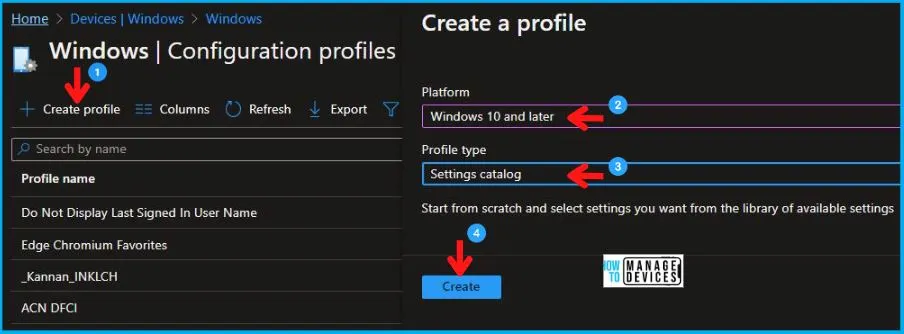
On the Basics tab pane, I provide a name for the policy as “Enable File Hash Computation Feature Policy.” Optionally, you can enter a policy description and proceed by selecting “Next”.
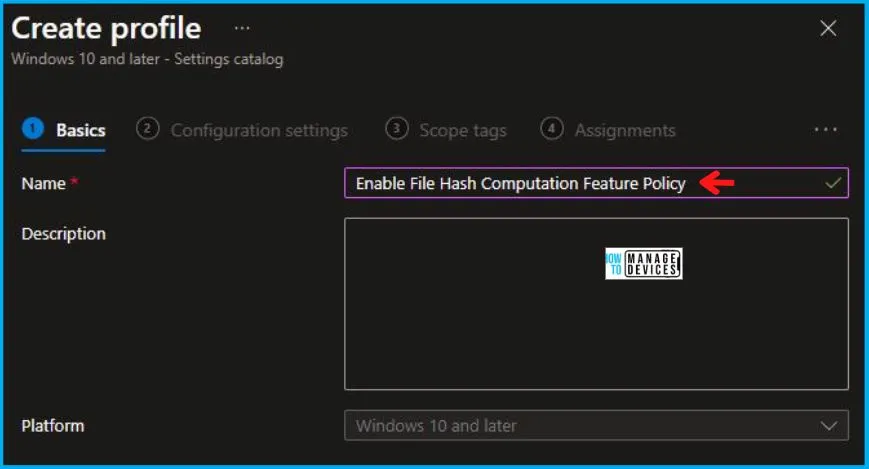
Now in Configuration Settings, click Add Settings to browse or search the catalog for the settings I want to configure.
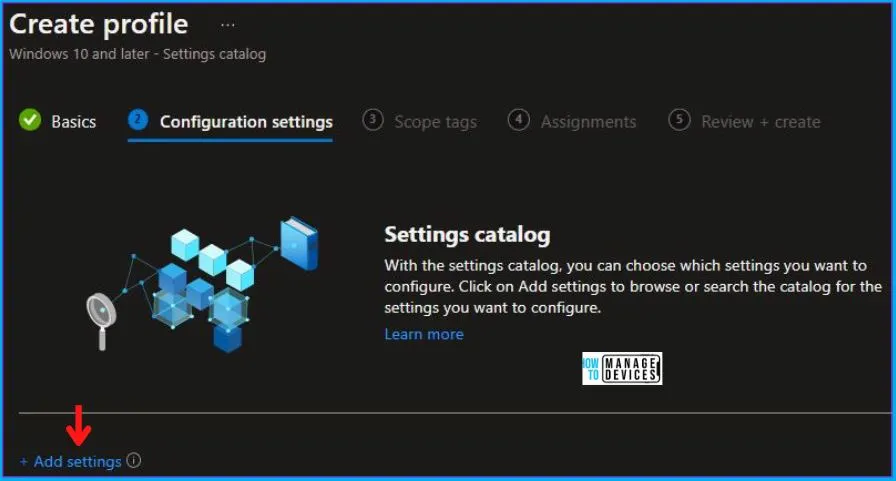
In the Settings Picker windows, I searched for the keyword Hsh, and among many, I found the category Administrative Templates\Windows Components\Microsoft Defender Antivirus\MpEngine and selected this.
When I selected that option as stated above, I saw one option, Enable file hash computation feature. After selecting that, click the cross mark at the right-hand corner, as shown below.
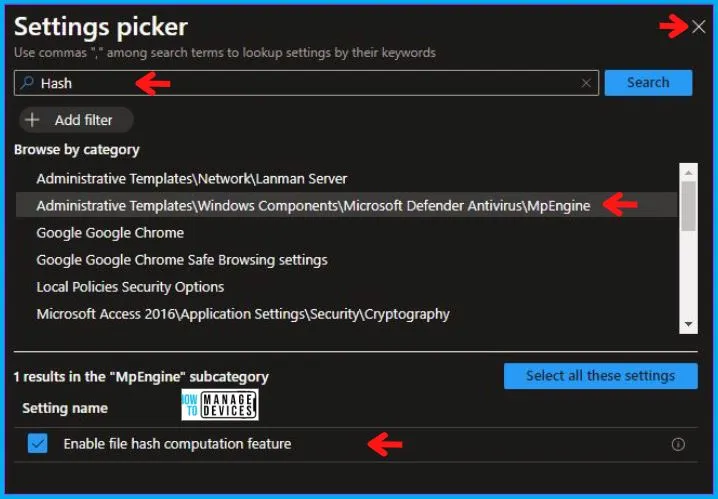
In the Administrative Templates, I set the Enable file hash computation feature to Enabled, as shown below in the image.
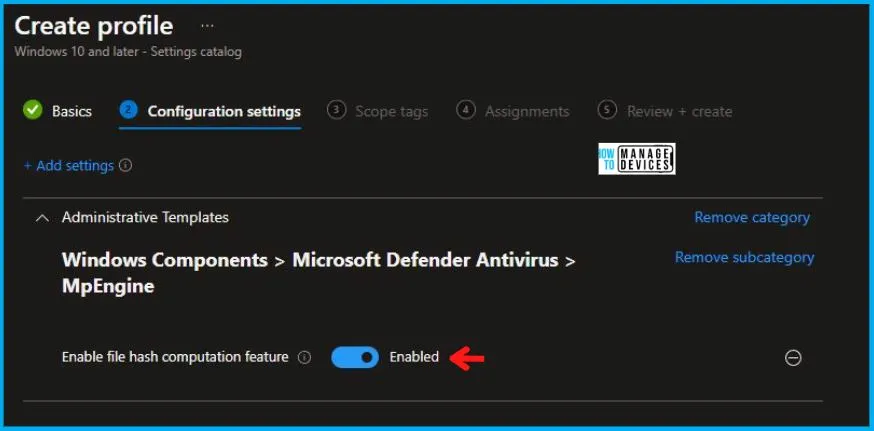
Using Scope tags, you can assign a tag to filter the profile to specific IT groups. One can add scope tags (if required) and click Next to continue. Now in Assignments, in Included Groups, you need to click on Add Groups, choose Select Groups to include one or more groups, and click Next to continue.
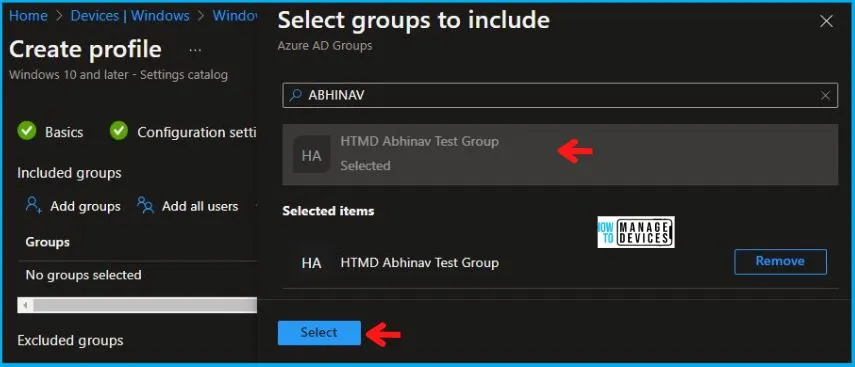
In the Review + Create tab, I review settings. After clicking on Create, changes are saved, and the profile is assigned.
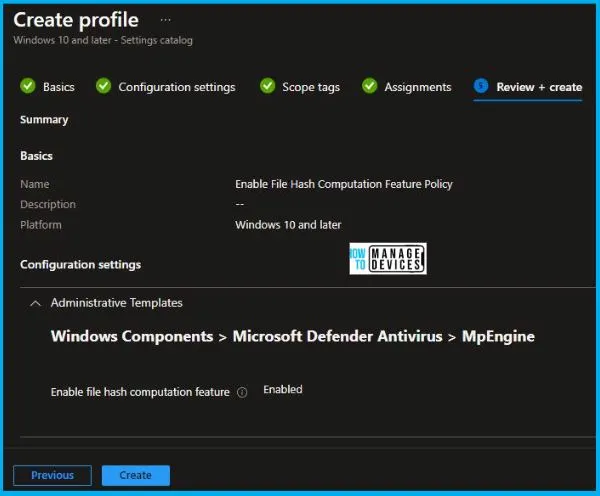
Upon successfully creating the “Enable File Hash Computation Feature Policy,” notification will appear in the top right-hand corner, confirming the action. You can also verify the policy’s existence by navigating to the Configuration Profiles list, where it will be prominently displayed.
Your groups will receive your profile settings when the devices check in with the Intune service. The Policy applies to the device.
Intune Report for Enable File Hash Computation Feature Policy
From Intune Portal, you can view the Intune settings catalog profile report, which provides an overview of device configuration policies and deployment status.
To track the assignment of the policy, you need to select the relevant policy from the Configuration Profiles list. Reviewing the device and user check-in status lets you determine if the policy has been successfully applied. If you require more detailed information, you can click on “View Report” to access additional insights.
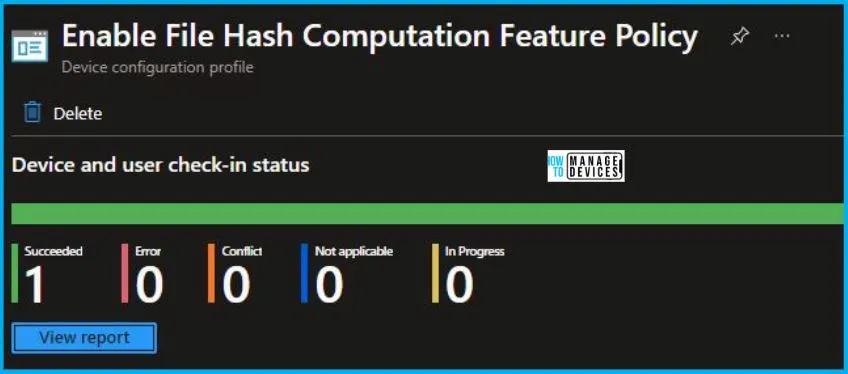
Intune MDM Event Log
To verify the successful implementation of String or integer policies on Windows 10 or 11 devices through Intune, you can leverage event IDs 813 and 814. These event IDs provide valuable insights into the application status of the policy as well as the specific value assigned to the policy on those devices. In the case of this particular policy, the value is String and is linked to the event ID 814.
By analyzing these event IDs, you can gain a clear understanding of the policy’s application status and the corresponding value associated with it on the devices in question.
To confirm this, you can check the Event log path – Applications and Services Logs – Microsoft – Windows – Devicemanagement-Enterprise-Diagnostics-Provider – Admin.
MDM PolicyManager: Set policy string, Policy: (MpEngine_EnableFileHashComputation), Area: (ADMX_MicrosoftDefenderAntivirus), EnrollmentID requesting merge: (5B88AEF1-09E8-43BB-B144-7254ACBBDF3E), Current User: (Device), String: (<enabled/>), Enrollment Type: (0x6), Scope: (0x0).
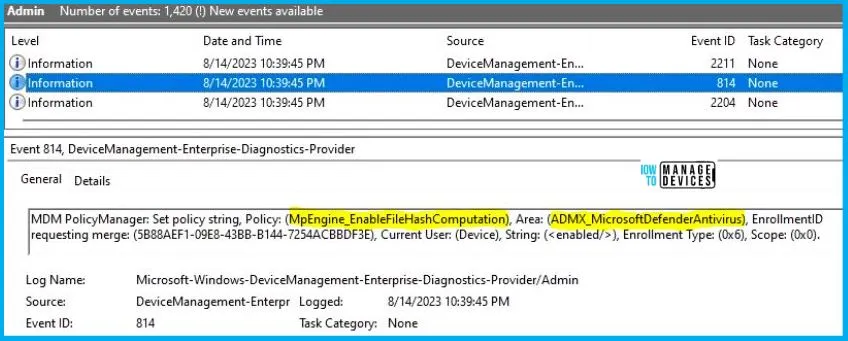
So when I open the above Event log, I found that it is successfully implemented. By reviewing the log entry shown in the above image, the Event Viewer, I came across essential information, including the Area and Enrollment ID. These details play a significant role in identifying the corresponding registry path. To locate the specific information, please consult the table provided below:
| Area | Policy | String | Scoped | Event ID |
|---|---|---|---|---|
| ADMX_MicrosoftDefenderAntivirus | MpEngine_EnableFileHashComputation | Enabled | Device | 814 |
The details presented in the table above for the Enable File Hash Computation Feature Policy Using Intune can be employed to access the registry settings that hold the group policy configurations on a specific computer. To accomplish this, you can execute “REGEDIT.exe” on the target computer and navigate to the precise registry path where these settings are stored.
- Computer\HKEY_LOCAL_MACHINE\SOFTWARE\Microsoft\PolicyManager\providers\5B88AEF1-09E8-43BB-B144-7254ACBBDF3E\default\Device\ADMX_MicrosoftDefenderAntivirus
When you navigate to the above path in the Registry Editor, you will find the registry key with the name MpEngine_EnableFileHashComputation. Refer to the table and image below.
| Registry Name | Value |
|---|---|
| MpEngine_EnableFileHashComputation | Enabled |

As I navigated to the given registry path, I found that the registry key had been created, and one can confirm by seeing the above image.
Author
Abhinav Rana is working as an SCCM Admin. He loves to help the community by sharing his knowledge. He is a B.Tech graduate in Information Technology.

Does this setting scans hash for .exe or it scans all the file types ?